Wednesday, November 29, 2006
I'm Moving
Namaste!
GeekZenDaddy
http://geekzendaddyzen.wordpress.com
Saturday, November 18, 2006
India should return Tawang to China
OK, this confuses me, but I'm not a super genius or even a mapmaker for that matter. China wants a Buddhist town back from India that is important to Tibetan Buddhists. As expected, they don't want to hand it over to China. HHuuummmm well how about this, if China gave Tibet back to the Tibetans, they could leave India and be able to go home. Yeah, I don't see that happening either.......
Zee News, Nov 15, 2006
Beijing, China -- Amid the heat generated by the latest Chinese claim of sovereignty over entire Arunachal Pradesh, prominent scholars here have backed Beijing's claim over Tawang, a strategic Buddhist town nestled in the Himalayas.
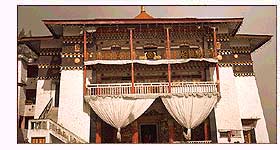
<< Tawang monastery
Speaking at the first-ever seminar on the 1962 India-China war and the boundary issue, held ahead of Chinese President Hu Jintao's maiden state visit to India from November 20, prominent Chinese scholars on South Asia voiced their firm support for Beijing's stand that India should return Tawang to China as part of the final settlement.
"India entered into Tawang, the birthplace of the sixth Dalai Lama, in 1951. For Tibetan Buddhism Tawang is important," the Deputy Director of the Institute of Asia-Pacific studies of the Chinese Academy of Social Sciences, Professor Sun Shihai said.
"In the negotiations for the settlement of the boundary issue, both countries should be sensitive to the national sentiments of each side," sun said.
Sun, who presided over the seminar, told here that Chinese scholars were of the view that both India and China should be willing to make 'adjustments' in the eastern and Western sectors of the disputed boundary for the final settlement of the border dispute.
"The McMohan Line, drawn by British is illegal. Successive Chinese governments have not accepted it. There is no question of the current socialist government accepting it as well. But we can discuss and make adjustments," he said.
The Free Buddhist Encyclopedia Project

While reading posts on another site, I saw mention of the Buddhist Encyclopedia. I surfed on over and was impressed. They have not been up for very long but have had over 1700 articles submitted. The BEP is in Wikipedia format so anyone with an account is able to submit or edit articles (within reason). After poking around, there is indeed a lot of good information. Why not wander over and check it out? http://buddhism.2be.net/Main_Page
Thursday, November 16, 2006
Buddha Quote
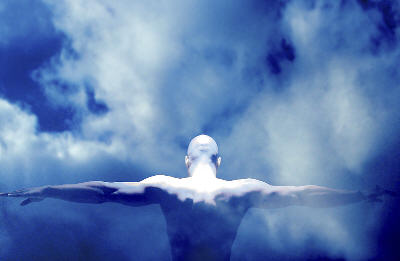 Subhuti asked the Buddha: "The highest, most awakened mind that you have attained - is that mind the unattainable?"
Subhuti asked the Buddha: "The highest, most awakened mind that you have attained - is that mind the unattainable?""Yes, Subhuti. With regard to that highest and most awakened mind, I have
not attained anything. That mind is everywhere equally. It cannot be
attained or grasped, but it can be realized. It is realized through the
practice of all good actions when they are done in the spirit of no self and
no object of self."
- Prajnaparamita
Wednesday, November 15, 2006
This Week's Words of Wisdom by Master Sheng Yen
 Whatever the circumstance, when you feel that you are suffering, remind yourself of this: "In this world there are many more people and situations that are worst than mine, so this is nothing." If you think along this way you will not blame others and more often, you will only think of the multitude of people who suffer and need our help.
Whatever the circumstance, when you feel that you are suffering, remind yourself of this: "In this world there are many more people and situations that are worst than mine, so this is nothing." If you think along this way you will not blame others and more often, you will only think of the multitude of people who suffer and need our help.
Tuesday, November 14, 2006
Zen Gardens
By MANNY BALDEMOR, ABS-CBN, Nov 13, 2006
If there was a moment of absolute clarity where one can perceive the nothingness and unity of all things, and at the same time gain positive enlightenment as a result, that period is Zen.
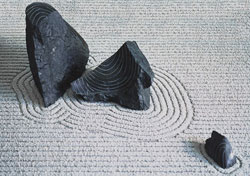 Manila, Philippines -- Zen Buddhism is one of the foundations of the Japanese culture. In A.D. 794 Japan's capital shifted from Narra to Kyoto, and for more than a thousand years remained as the center of government. Although Tokyo is the present capital of the country, it cannot be denied that much of old Japan remains in Kyoto, which to this day is clearly the major cultural center of Japan.
Manila, Philippines -- Zen Buddhism is one of the foundations of the Japanese culture. In A.D. 794 Japan's capital shifted from Narra to Kyoto, and for more than a thousand years remained as the center of government. Although Tokyo is the present capital of the country, it cannot be denied that much of old Japan remains in Kyoto, which to this day is clearly the major cultural center of Japan.
Buddhism came to Japan in the 6th century initially competing with existing Shinto beliefs, Japan's native religion. The former was originally passed on from Korea, and later from China. After hundreds of years, Zen Buddhism was established as a complex form of Buddhism particularly favored by the military class and was Japan's distinctive contribution to the religion.
Zen is a shortened form of Zenna from the Sanskrit term "dhyânam," which means meditation or contemplation. One of the central practices of Zen is Zazen, which means to meditate in a sitting position. Another is through Koan, the telling of certain stories and anecdotes (e.g. if a leaf falls inside a forest, does it make a sound?) pertaining to Zen and meditating on the deep questions and answers they elicit. Zen Buddhism involves introspective meditation, and through a disciplined simple lifestyle, a person can let go of worldly desires and achieve enlightenment, which is the main goal of Buddhism in general. By calming the mind, sitting meditation and emptying one's self, a person can dispel and discover self-knowledge.
Zen gardens are designed for practitioners of Zen to induce contemplation and meditation. The garden is both a philosophical statement and an object of aesthetic appreciation. Japanese gardens aim to imitate nature and the Holy Land for Zen garden enthusiasts are still in Kyoto, which has hundreds of Buddhist temples and monasteries. Everything is simplified and distractions are eliminated.
The dry garden of Roanji in Kyoto is the best example of a Zen garden (created in 1500 by Soami). The main elements comprise of rocks and sand—the sea is symbolized by furrows in a layer of sand suggesting ripples; rocks suggestive of a waterfall; and 15 stones forming islands in a sea of raked pebbles. A true haven for one's personal search for tranquility.
What is your moment of Zen?
Tuesday, November 07, 2006
Zen Quote of the Day

If I am holding a cup of water and I ask you, "is the cup empty?" you will say "No, it is full of water." But if i pour out the water and I ask you again, you may say, "yes, it is empty." but, empty of what?....My cup is empty of water, but it is not empty of air. To be empty is to be empty of something..... When Avalokita [Kuan-Yin, or Kannon, the bodhisattva who embodies Compassion] says [in the Heart Sutra] that the five skandas are equally empty, to help him be precise, we must ask "Mr. Avolikta, empty of what?" The five Skandas, which may be translated into english as the five heaps, or five aggregates, are the five elements of that comprise the human being.....In fact, these are really five rivers flowing together in us: the river of form, which means our body, the river of mental formations, the river of feelings, the river of perceptions and the river of consciousness. They are always flowing within us... Arvalokit looked deeply into the five skhandas... and discovered none of them can be by itself alone....Form is empty of a separate self, but it is full of everything else in the cosmos. The same is true with feelings, perceptions, mental formations, and consciousness.
Thich Nat Hanh
The Heart of Understanding
Wednesday, November 01, 2006
India enshrines Buddha's remains after 2000 years
By Laura MacInnis, The Star (Reuters), Oct 29, 2006
MUMBAI, India -- Thousands of Buddhists gathered in Mumbai on Sunday to lay to rest part of the ashes and bones of Lord Buddha in a ceremony resurrected after almost 2000 years.
 << onclick="BLOG_clickHandler(this)" class="blsp-spelling-error" id="SPELLING_ERROR_3">Mumbai yesterday. Thousands of Buddhists gathered for the ceremony held to lay to rest part of the ashes and bones of Lord Buddha
<< onclick="BLOG_clickHandler(this)" class="blsp-spelling-error" id="SPELLING_ERROR_3">Mumbai yesterday. Thousands of Buddhists gathered for the ceremony held to lay to rest part of the ashes and bones of Lord Buddha
Monks in flowing orange robes chanted hymns from scriptures as the remains were lowered into a shallow pit on top of a 90-ft high stone dome, as part of celebrations to mark the 2,550th anniversary of the spiritual leader's enlightenment.
Organisers of the ceremony said this was the first time in around 2,000 years that Buddha's mortal remains were being enshrined.
"The relics now kept in this magnificent pagoda came from an ancient dome discovered during an archaeological expedition in south India in early-1900s," Acharya S.N. Goenka told reporters.
After Buddha's death, his remains were divided and kept in eight separate domes built by his disciples across Asia.
They were later taken by Buddhist convert Indian emperor Asoka, who placed them in many smaller domes about 2000 years ago.
The remains being enshrined on Sunday were found in an ancient pagoda in southern India in 1920 and have been kept in a Buddhist monastery for over 85 years, before being handed over for enshrining.
Buddhists, some of whom came from other parts of the world, including the United States, Britain, Australia and Cambodia, sat in meditation inside the dome, which can accommodate 8,000 people, many looking up in the direction of the roof where the remains of their guru lay.
According to believers, the enshrined relics of their leader emit spiritual energy and vibrations which helps meditation.
The organisers said the newly-constructed dome was unique as it was not only the world's largest stone dome unsupported by pillars, but was built with millions of inter-locking stones using ancient architectural techniques.
"No cement, concrete or metal has been used. There are no pillars to support the dome which is 280 feet in diameter," said Subhash Chandra, a Buddhist and an Indian media baron.
http://www.buddhistchannel.tv/index.php?id=42,3351,0,0,1,0Sunday, October 29, 2006
Sitting

I have been very lax on my sitting lately. My work schedule has been different for the last two weeks throwing everything off. It would be easy to blame not sitting on this, but I would be lying to myself. I have been putting it off to do other mindless things like watching TV. I can feel it beginning to affect my life already. I am more moody, touchy, jumpy and even a little paranoid at work. It's amazing how just sitting for 30 minutes a day keeps my head in place :-)
Online Course at Ashoka Website
 |  |  |
Ashoka is a great site to go for online Buddhist classes. Recently they released a class by my master, Master Sheng Yen called The Legacy of Chan. I have gone through about half of it so far and it is done very well. I am not sure who did the translating for Master Sheng Yen, but it captures the flair and style of his other writings. Hop on over and give it a whirl!
From the site....
This course provides an introduction to the nature and style of Chan Buddhism, which has been practiced in China since around the 6th century C.E. and, when exported to Japan around the 11-12th century, became the source of "Zen." Rather than attempt to present in depth every important aspect and feature of Chan Buddhism, this course — by presenting some of the highlights of Chan — hopefully conveys its flavor and unique approach. In the near future you will be able to explore aspects of Chan in greater depth on Ashoka.
Friday, October 20, 2006
This Week's Words of Wisdom by Master Sheng Yen
 Everything is impermanent, everything is selfless, and to experience this selflessness or emptiness is the experience the quiescence of Nirvana, Buddha nature and enlightenment.
Everything is impermanent, everything is selfless, and to experience this selflessness or emptiness is the experience the quiescence of Nirvana, Buddha nature and enlightenment.
Sunday, October 15, 2006
Ah an answer, perhaps this is why I am Hindu in India now....
India's Untouchables turn to Buddhism in protest at discrimination by Hindus
By Justin Huggler, The Independent, October 13, 2006
New Delhi, India -- Across India this month, thousands of Hindus from the former Untouchable castes are converting to Buddhism in protest at the continuing discrimination they face. Mass conversion ceremonies are being held throughout the month, from Delhi in the north, to Hyderabad in the south. Organisers are claiming that more than 100,000 people have already converted.
 Conversion is a highly charged political issue. Several states have passed laws this year making it harder to convert, and the mass ceremonies will infuriate Hindu nationalist parties that have been campaigning to stop lower caste Hindus changing their religion.
Conversion is a highly charged political issue. Several states have passed laws this year making it harder to convert, and the mass ceremonies will infuriate Hindu nationalist parties that have been campaigning to stop lower caste Hindus changing their religion.
But for many Dalits, as Untouchables are now known, conversion is the only way to escape the oppression they still face in Hindu society. Untouchability has been illegal in India since independence, but it is still commonly practised. In many villages Dalits are not allowed to drink clean water from a well. In some areas, tea shops keep a different glass for Dalits to use, so higher-caste Hindus are not "polluted" by drinking from the same vessel, even after it has been washed. After the 2004 tsunami, Dalit survivors in Tamil Nadu were prevented from sharing water in relief camps.
See rest of article HERE.
Friday, October 13, 2006
Quote from the Buddha

Like the moon,
This Week's Words of Wisdom by Master Sheng Yen
 Compassion was the beginning of buddhism, and it is the essence of Buddhism.
Compassion was the beginning of buddhism, and it is the essence of Buddhism.
Saturday, October 07, 2006
Zazen
We call it practice, but even that's one word too many.
In any case, there remains this one thing that cannot be
forgotten, no matter which position one takes.
It's the same one we practice to forget, and so
be enlightened by the ten thousand things.
"To be enlightened by the ten thousand things is
to free one's body and mind and those of others.
No trace of enlightenment remains, and this
traceless enlightenment is continued forever."
~Dogen
Bodhidharma Day!
 Bodhidharma is considered the first Chinese Chan Patriarch. Current Chinese linage is about the 58th. Bodhidharma sat in a cave for 9 years until the Second Patriarch showed up. Only after the Sixth Patriarch, Chan flourished in China.
Bodhidharma is considered the first Chinese Chan Patriarch. Current Chinese linage is about the 58th. Bodhidharma sat in a cave for 9 years until the Second Patriarch showed up. Only after the Sixth Patriarch, Chan flourished in China. Based on my Chinese calendar, November 25 is the birthday for Bodhidharma in this the 2550th year of Shakymuni. Today is also the day after the Mid Autumn Festival. The moon is at its fullest and it is an excellent day for meditation.
This Week's Words of Wisdom by Master Sheng Yen
 The efficacy of the prayer lies in the pure sincerity of the praying, which comes from one's strength of mind, and the strength of one's vows
The efficacy of the prayer lies in the pure sincerity of the praying, which comes from one's strength of mind, and the strength of one's vows
Tuesday, October 03, 2006
The Four Great Bodhisattva Vows
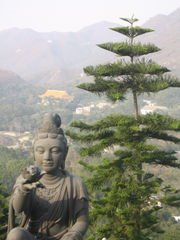
SENTIENT BEINGS WITHOUT NUMBER WE VOW TO ENLIGHTEN
For a Bodhisattva, the eradication of one's own suffering is joined with the desire to aid in the eradication of all others' suffering as well. The real Bodhisattva identifies the immeasurable distress of all sentient beings as his own. With this Immeasurable Compassion (Maha-karuna), one can take the second vow:
VEXATIONS WITHOUT NUMBER WE VOW TO ERADICATE
The desire to win Supreme Bodhi, convert and liberate sentient beings, aid in the eradication of their distress, etc., should not be an impulse based on idle sentimentality or romantic notions of spiritual life. This noble aspiration can only come to completion provided that there is a strong foundation of wisdom. With wisdom only, and not otherwise, can one spread the Dharma and assist living beings. This wisdom arises from a keen desire to learn and practice the Buddha-dharma. Therefore, the Buddha said, "All Buddhas in the three periods arise from learning and practice." One who is not willing to learn will remain eternally foolish, and what foolish man or woman ever completed the Bodhi Tao, spread Dharma and assisted sentient beings? See: THE BUDDHA: Five Qualities of a Dharma Teacher.
As there is immeasurable distress in the lives of sentient beings, there are innumerable methods of Dharma practice. Therefore, the third vow of great compassion is as follows:
LIMITLESS APPROACHES TO THE DHARMA WE VOW TO MASTER
When one perceives the suffering of sentient beings, one vows to Enlighten sentient beings without number when perceiving the distress in one's life and that of others, one vows to eradicate vexations without end. Perceiving the myriad Dharma doors to Enlightenment, one vows to master them all. Perceiving the truth of Nirvana, one vows to attain the Supreme Bodhi.
THE SUPREME ENLIGHTENMENT WE VOW TO ACHIEVE
Source http://www.angelfire.com/electronic/awakening101/four-vows.htmlEnlightenment is Bodhi; Supreme Enlightenment is the Anuttara Samyak Sambodhi or the Buddha Fruit. Determining the Bodhicitta means using the faith of our worldly minds to vow to complete this path. However, if one is to complete this vow, one should have the support of the other three Great Vows. To arrive at Anuttara-Samyak-Sambodhi, one should have the desire to spread the Buddha-dharma and effect the liberation of all sentient beings.
Zen Classics - The Diamond Sutra
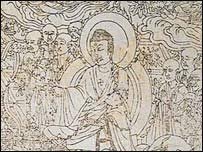
The Diamond Sutra was the second sutra I studied. It in conjunction with the Heart Sutra sums up the essence of Zen Buddhism. This sutra contains the Bodhisattva Vow, the concepts of emptiness as well as directives on mindfulness and constant meditation and practice. Here is part of the introduction from a translation that I really like...... LINK
The Diamond Sūtra (Vajracchedika-prajñāpāramitā-sūtraspan>) has maintained a high degree of popularity in the Mahāyāna Buddhist tradition for over a millenium, especially in East Asia, and most importantly within the East Asian meditation (Chan/Seon/Zen/Thien) school, where it has been recited, taught, and commented on extensively up to the present day. One reason for its popularity is its brevity — it can be chanted in about forty minutes, which means that it is something that an average person can memorize without superhuman effort. More important, though, is the basic resonance of the text's message with a core aspect of Chan doctrine/practice — the theme of "non-abiding." Non-abiding, in a Buddhist, and especially a Chan context, refers to the continual practice (i.e., not just while one is sitting in zazen) of being aware of the stoppings and goings of the mind, and avoiding being tricked and ensnared by the web of mental constructs that one continually weaves for oneself. The ongoing proliferation of these deluded constructs has as its causes and conditions not only in the thought processes in which one is engaged at the present moment, but also the flowing river one's entire multi-lifetime load of previous karma. And not only one's own karma, but the linguistic/karmic flow of one's entire culture.
A vitally important message of the Diamond Sūtra is that non-abiding should not be misconstrued as a nihilistic sort of practice. On the other hand, it also does not imply simply giving free reign to one's thoughts, since then, one is certainly going to get further wrapped up in the dense web of one's own spinning. Non-abiding necessitates the kind of moment-to-moment attentiveness that is awesome in its required subtlety. Nonetheless, with just a modicum of experience in meditative practice, the new student of the Diamond Sutra will no doubt begin to get some sort of feel for what is going on in this text. In a sense, it is simple: the thoughts, labels, signs, characteristics, etc., that we associate with given things, are nothing more than labels, and should not be imputed as the reality of the thing in itself, thus becoming reified objects of our desire and dislike. Yet there is also such a thing as thinking and seeing correctly, and it is permissible, nay, necessary, to use these notions, signs, and labels to function in daily life, and especially to study Buddhism for the aim of attaining enlightenment. Thus, Buddhism (and any other responsible contemplative tradition) cannot condone any attitude that recommends negating, or running away from any of the experiences that impinge upon our consciousness. Nor can it maintain that there is any such thing as a fixed, or final truth. As the Daodejingan> says, "The Way that can be taught is not the true Way." Either of these extreme options are none other than another form of abiding, or appropriation.
Source http://www.hm.tyg.jp/~acmuller/bud-canon/diamond_sutra.html
Friday, September 29, 2006
This Week's Words of Wisdom by Master Sheng Yen
 We all have attachments. They may be material or mental; they may be worldly, philosophical or physical. Attachments may be superficial and transient or deeply ingrained and stubbornly fixed. Attachments have one thing in common, however, they all create aggravation, turmoil in our lives.
We all have attachments. They may be material or mental; they may be worldly, philosophical or physical. Attachments may be superficial and transient or deeply ingrained and stubbornly fixed. Attachments have one thing in common, however, they all create aggravation, turmoil in our lives.
Wednesday, September 27, 2006
Timing
 Rev. Harvey So Daiho Hilbert, Ph.D.
Rev. Harvey So Daiho Hilbert, Ph.D. http://www.zencenteroflascruces.org
Monday, September 25, 2006
Buddhism can help end suffering, Jet Li says
Buddhism can help end suffering, Jet Li says
The Record, Sept 23, 2006
San Francisco, USA -- Jet Li is famous for his fists and kicks, but he'd like his compassion to be a hit, too.

<<>
Li, who noted that a quarter of a million people committed suicide in China in 2003, said he hopes that he and his latest film, Jet Li's Fearless, can help make a difference.
"I would like to spend more of my energy practising Buddhism and helping younger Chinese people to understand life,'' he told the San Francisco Chronicle. "When people commit suicide, they cause 10 people to suffer. So this is causing millions and millions of people to suffer.''
"The Buddhism idea is to look back, to look into yourself. It's a feeling,'' he said. "The feeling is different from the material. You need to make yourself happy from inside your heart.''
Sunday, September 24, 2006
Fun Quiz on Karma
You Have Good Karma |
 In general, you like to do the right thing when it comes to others. Your caring personality really shines through. Sure, you have your moments of weakness - and occasionally act out. But, all in all, you're karma is good... even with those few dark spots. |
Saturday, September 23, 2006
Where is the Buddha?
Where is the Buddha?
Last book written by the late Chief Ven. Dr K Sri Dhammananda
The Buddhist Channel is pleased to present to you the last book written by the late Chief Ven. Dr K Sri Dhammananda. To fulfill the wish of the late venerable, this e-Book shall be distributed free of charge. Please help to fulfill his wish by forwarding it to as many people as you can.
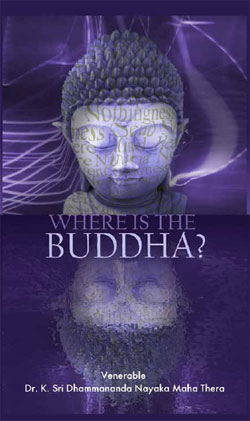
Download E-Book Here
(PDF 100K)
As part of the effort to distribute the book as widely as possible, the Buddhist Channel have also undertaken to work with different parties from various countries to have it printed in local editions.
Among the initial selected locations which we will be giving priority to are: Sri Lanka - 5,000 copies, India - 5,000 copies, Singapore - 2000. We are also planning to have the book translated in Thai, Sinhalese, Khmer, Vietnamese, Korean, Chinese and Japanese.
We welcome donations of any amount to support our effort to fulfill the late venerable's final wishes.
We would like to thank the following for their contribution:
- Tan HL (Sarawak) - RM 300.00
- Chan Sau Kheng - RM 50.00
Please click here to make a donation:
Sadhu! Sadhu! Sadhu!
May your kind generosity bring light to help dispel ignorance.
With loving kindness
Kooi Fong Lim
September 22, 2006
for the Buddhist Channel
Letter from Ven. Thich Nhat Hanh to President George W Bush
Plumvillage, Published on the Buddhist Channel, Sept 22, 2006
"Our home is large enough for all of us. Let us go home as brothers and sisters." - Ven Thich Nhat Hanh
Thenac, France -- Ven. Thich Nhat Hanh recently wrote a handwritten letter to US President George W. Bush about a dream he had of his brother. He shared this dream of his with the President and implored Mr Bush to rethink the situation in the Middle East. Here is the letter in full.
Honorable George W. Bush
The White House
Washington DC, USA
Plum Village
Le Pey 24240
Thenac, France
Dear Mr President
Last night, I saw my brother (who died two weeks ago in the USA) coming back to me in a dream. He was with all his children. He told me, "Let's go home together." After a millisecond of hesitation, I told him joyfully, "Ok, let's go."
Waking up from that dream at 5 am this morning, I thought of the situation in the Middle East; and for the first time, I was able to cry. I cried for a long time, and I felt much better after about one hour. Then I went to the kitchen and made some tea. While making tea, I realized that what my brother had said is true: our home is large enough for all of us. Let us go home as brothers and sisters.
Mr. President, I think that if you could allow yourself to cry like I did this morning, you will also feel much better. It is our brothers that we kill over there. They are our brothers, God tells us so, and we also know it. They may not see us as brothers because of their anger, their misunderstanding, and their discrimination. But with some awakening, we can see things in a different way, and this will allow us to respond differently to the situation. I trust God in you; I trust Buddha nature in you.
Thank you for reading.
In gratitude and with brotherhood,
Thich Nhat Hanh
Plum Village
Tuesday, September 19, 2006
I'm a Hindu! uummmm what?
Gujarati government defines Jainism and Buddhism as sects of Hinduism
Saturday, September 16, 2006
The Eight Auspicious Symbols
THE EIGHT AUSPICIOUS SYMBOLS
This set of symbols is very popular in Tibet, but is also known in Sanskrit as 'Ashtamangala', ashta means eight and mangala means auspicious..
The Umbrella or parasol embodies notions of wealth or royalty, for one had to be rich enough to possess such an item, and further, to have someone carry it. It points to the "royal ease" and power experienced in the Buddhist life of detachment. It also symbolises the wholesome activities to keep beings from harm (sun) like illness, harmful forces, obstacles and so forth, and the enjoyment of the results under its cool shade.
 The Golden Fish; were originally symbolic of the rivers Ganges and Yamuna, but came to represent good fortune in general, for Hindus, Jain and Buddhists. Within Buddhism it also symbolises that living beings who practice the dharma need have no fear to drown in the ocean of suffering, and can freely migrate (chose their rebirth) like fish in the water.
The Golden Fish; were originally symbolic of the rivers Ganges and Yamuna, but came to represent good fortune in general, for Hindus, Jain and Buddhists. Within Buddhism it also symbolises that living beings who practice the dharma need have no fear to drown in the ocean of suffering, and can freely migrate (chose their rebirth) like fish in the water.
The Treasure Vase; is a sign of the inexhaustible riches available in the Buddhist teachings, but also symbolises long life, wealth, prosperity and all the benefits of this world. (There is even a practice which involves burying or storing treasure vases at certain locations to generate wealth, eg. for monasteries or dharma centers.)
The Lotus is a very important symbol in India and of Buddhism. It refers to the complete purification of body, speech and mind, and the blossoming of wholesome deeds in liberation. The lotus refers to many aspects of the path, as it grows from the mud (samsara), up through muddy water it appears clean on the surface (purification), and finally produces a beautiful flower (enlightenment). The white blossom represents purity, the stem stands for the practice of Buddhist teachings which raise the mind above the (mud of) worldly existence, and gives rise to purity of mind.
An open blossom signifies full enlightenment; a closed blossom signifies the potential for enlightenment.
From the website Exotic India Art:
Prayer Flags

Prayer Flags
Originally uploaded by jocieposse.
Picture of prayer flags I found on Flickr.com. Uploaded by jocieposse on 23 Aug '06, 2.44pm PDT.
Don't ask why - just be
Commentary: Waking Up
By Don Munro
ReligionAndSpirituality.com
My career valleys offer plenty of opportunity for getting comfortable with feelings of insecurity and fear. For example, I hate it when I hit a dry spell of writing assignments, and I can get somewhat desperate.
To deal with this, I sometimes make good choices; I'll update the resumé or try to mine clients in a new industry. Other times, my judgment is off the mark. Once, I was so fearful about a rough patch that I took a night job cleaning toilets in one of the local schools. (I have nothing against this kind of work, it just left me with no time to write... and smelling like Pine Sol.)
But the trouble is not really that there is sometimes more doodles than actual appointments in my appointment book. The bigger problem is what I may do with the fear that arises in me when I hit a rough patch.
When I'm confronted with a slowdown, I struggle with a disturbing sense of restlessness, unease, insecurity. It can get worse. I've been known to feed the monsters with scary stories, escalating my suffering to unbridled worry.
Please visit the rest of this great article here... LINK
Thursday, September 14, 2006
This Week's Words of Wisdom by Master Sheng Yen
 Let go of the past and future and just concentrate on the present.
Let go of the past and future and just concentrate on the present.
Zen Classics - The Heart Sutra
I
 THE
THEHEART SUTRA
Here's a little something I made for myself that I thought some of you might find useful. I went on and on in Hardcore Zen about the Heart Sutra. For those who don't have the book, the Heart Sutra is a short poetic piece written fairly early on in the history of Buddhism -- though probably a few hundred years after Buddha himself died -- which encapsulates most of what has come to be known as Zen Buddhism. The Heart Sutra is the standard sutra chanted at pretty much any relevant occasion at Zen temples and centers. It works for everything from morning services to funerals and everything in between.
I've been trying to commit it to memory. Since I can kinda sorta read the Chinese characters and since I know the meaning, I found it was easier to memorize if I associated what I was chanting to what it meant rather than just trying to memorize the syllables. So I put together a version where the Chinese characters, their pronunciation in Roman letters and the English translation of each line are side-by-side for easy reference.
The English translation I've used is based upon the ones by Kobun Chino and Gudo Nishijima with a bit of my own re-interpretation thrown in. I tried to follow the Chinese grammar in the English translation so that it would be easier to match the Chinese directly to the English. Since word order in Chinese and English is fairly close, this doesn't create too many problems, though there are a couple awkward spots.
I claim no ownership or copyright of any kind on this material. So feel free to use it in any way you please without asking permission from me. Copy it. Distribute it. Re-write it as a pornographic limerick if you want.
If your browser can deal with Japanese, you'll be able to view it below. If not, try downloading this PDF file:
I've followed the Japanese practice of indicating lengthened o's and u's by adding a "u" after them. So, for example, the syllable "sou" is pronounced as a long "so" and not "sow." The letter "i" is pronounced "ee" and the letter "e" is pronounced "eh."
To chant it like a pro, just adopt a real low monotone Robby the Robot type voice and chant each character (separated by dashes in the Romanized version) for an even length of time. That means a two syllable character such as "satsu" lasts as long as a one syllable character. Don't go up or down at the ends of the lines. But you can drop your voice on the syllable "gyou" at the end of the first line and the end of the last line (but only those two times).
If you spot any errors, please let me know and I'll fix them (errors fixed 2/1/05, thanks to Shonen Dunley).
Have fun!
ma-ka-han-nya-ha-ra-mi-ta-shin-gyou
The Great Heart of Wisdom Sutra
観自在菩薩行深般波羅蜜多時
kan-ji-zai-bo-satsu-gyou-jin-han-nya-ha-ra-mi-ta-ji
Avalokiteshvara Bodhisattva while practicing deep Prajna Paramita
照見五薀皆空度一切苦厄
shou-ken-go-on-kai-kuu-do-is-sai-ku-yaku
Perceived all five skandhas were empty and was saved from suffering and distress
舍利子色不異空
sha-ri-shi-shiki-fu-i-kuu
Shariputra, form is no different from emptiness
空不異色
kuu-fu-i-shiki
Emptiness is no different from form
色即是空
shiki-soku-ze-kuu
That which is form is emptiness
空即是色
kuu-soku-ze-shiki
That which is emptiness is form
受想行識 亦復如是
juu-sou-gyou-shiki-yaku-bu-nyo-ze
Feelings, perceptions, impulses, consciousness, the same is true of these
舍利子是諸法空相
sha-ri-shi-ze-sho-hou-kuu-sou
Shariputra, all dharmas are marked with emptiness
不生不滅
fu-shou-fu-metsu
(They) do not appear or disappear
不垢不浄
fu-ku-fu-jou
are not tainted or pure
不増不減
fu-zou-fu-gen
do not increase or decrease
是故空中無色
ze-ko-kuu-chuu-mu-shiki
Therefore in emptiness no form,
無受想行識
mu-juu-sou-gyou-shiki
no feelings, perceptions, impulses, consciousness
無眼耳鼻舌身意
mu-gen-ni-bi-zes-shin-i
no eyes, ears, nose, tongue, body, mind
無色声香味触法
mu-shiki-shou-kou-mi-soku-hou
no color, sound, smell, taste, touch, object of mind
無限界乃至無意識界
mu-gen-kai-nai-shi-mu-i-shiki-kai
no realm of eyes and so forth until no realm of mind consciousness
無無明亦無無明尽
mu-mu-myou-yaku-mu-mu-myou-jin
no ignorance and also no extinction of ignorance
乃至無老死亦無老死尽
nai-shi-mu-rou-shi-yaku-mu-rou-shi-jin
and so forth until no old age and death and no extinction of old age and death
無苦集滅道
mu-ku-shuu-metsu-dou
no suffering, origination, stopping, path
無智亦無得
mu-chi-yaku-mu-toku
no cognition also no attainment
以無所得故
i-mu-sho-tok-ko
with nothing to attain
菩提薩埵依般若波羅蜜多故
bo-dai-sat-ta-e-han-nya-ha-ra-mi-ta-ko
the Bodhisattva depends upon Prajna Paramita
心無罣礙
shin-mu-ke-ge
and (his) mind is no hindrance
無罣礙故無有恐怖
mu-ke-ge-ko-mu-u-ku-fu
without any hindrance no fear exists
遠離一切顛倒無想
on-ri-is-sai-ten-dou-mu-sou
far apart from every inverted view
究竟涅槃
ku-kyou-ne-han
(he) dwells in Nirvana
三世諸仏
san-ze-shou-butsu
All Buddhas in the Three Worlds
依般若波羅蜜多故
e-han-nya-ha-ra-mi-ta-ko
depend on Prajna Paramita
得阿耨多羅三藐三菩提
toku-a-noku-ta-ra-san-myaku-san-bo-dai
and attain complete unsurpassed enlightenment
故知般若波羅蜜多
ko-chi-han-nya-ha-ra-mi-ta
Therefore know the Prajna Paramita
是大神呪
ze-dai-jin-shu
is the great transcendent mantra
是大明呪
ze-dai-myou-shu
is the great bright mantra
是無上呪
ze-mu-jou-shu
is the utmost mantra
是無等等呪
ze-mu-tou-dou-shu
is the supreme mantra
能除一切苦真実不嘘
nou-jo-is-sai-ku-shin-jitsu-fu-ko
which is able to relieve all suffering and is true, not false
故説般若波羅蜜多呪
ko-setsu-han-nya-ha-ra-mi-ta-shu
so proclaim the Prajna Paramita mantra
即説呪曰
soku-setsu-shu-watsu
proclaim the mantra that says
揭諦揭諦波羅揭諦
gya-te-gya-te-ha-ra-gya-te
gone,gone, gone beyond
波羅僧揭諦菩提薩婆訶
ha-ra-sou-gya-te-bo-ji-so-wa-ka
gone all the way beyond, Bodhi Svaha!
般波心経
han-nya-shin-gyou
heart sutra
Buddhism 101 - Part 2
 The 8-Fold Path. The path is the extension of Noble Truth number four. This is the checklist that the Buddha gave to us to help us reach nirvana aka the end of suffering. The path is divided up and graphically represented by a wheel.
The 8-Fold Path. The path is the extension of Noble Truth number four. This is the checklist that the Buddha gave to us to help us reach nirvana aka the end of suffering. The path is divided up and graphically represented by a wheel.The three major categories of the path are wisdom, ethical conduct and mental discipline sometimes called meditation. In a broad sense that is accurate, but meditation (the sitting kind) is only a part of the mental discipline category.
From Wikipedia - In all of the elements of the Noble Eightfold Path, the word "right" is a translation of the word samyañc (Sanskrit) or sammā (Pāli), which denotes completion, togetherness, and coherence, and which can also carry the sense of "perfect" or "ideal".
Though the path is numbered one through eight, it is generally not considered to be a series of linear steps through which one must progress; rather, as the Buddhist monk and scholar Walpola Rahula points out, the eight elements of the Noble Eightfold Path "are to be developed more or less simultaneously, as far as possible according to the capacity of each individual. They are all linked together and each helps the cultivation of the others.
* Wisdom (Sanskrit: prajñā, Pāli: paññā)
1. Right understanding
2. Right intention
* Ethical conduct (Sanskrit: śīla, Pāli: sīla)
3. Right speech
4. Right action
5. Right livelihood
* Mental discipline (Sanskrit and Pāli: samādhi)
6. Right effort
7. Right mindfulness
8. Right concentration
As time goes on I will try to address each of the 8 points, but please keep in mind entire books have been written on this topic. Here is a great study LINK for more information.
Buddhism 101 - Part 1

The backbone of all Buddhist teachings is the 4 Noble Truths. The first sermon that the newly enlightened historical Buddha gave was about the 4 Truths. This sermon was given in a deer park and has come to be known as the Samyutta Nikaya.
Therefore, the Buddha said in the Samyutta Nikaya: These Four Noble Truths, monks, are actual, unerring, not otherwise. Therefore, they are called noble truths.
So, what are these truths? Well......
1. Life entails suffering (dissatisfaction) also known as duhkha
2. Dissatisfaction is a result of suffering (craving/desire) also known as trishna
3. Suffering can be stopped also known as nirvana
4. The way to end suffering is with the 8-fold path also known as maggha
Again from the Samyutta Nikaya: Why have I declared (the four noble truths)? Because it is beneficial, it belongs to the fundamentals of the holy life, it leads to disenchantment, to dispassion, to cessation, to peace, to direct knowledge, to enlightenment, to Nirvana. That is why I have declared it.
Here is a great LINK to a study guide. It goes into great detail on something that seems so simple :-)
Welcome and Intro
My first couple of post will be about the most important tenants in Buddhism and Zen. No, Buddhism and Zen are not the same thing. There are several 'flavors' of Buddhism if you will. Zen (Japanese translation of the Chinese C'han) is know as the sudden enlightenment school. Zen is a subset of Mahayana Buddhism. LOL, ok another term there :-) There are three major categories or types of Buddhism. They are Theravada, Mahayana and the Vajrayana or know to most as the Tibetan path.
I am a C'han practitioner affiliated with a Chinese temple in my area. As a C'han practitioner I have more religious "things" going on then a Zen purist would. Trust me, it's convoluted, but i Will explain to the best of my ability as time goes on. So hang on, it just might be a very bumpy ride :-) Here is a great overview of Buddhism from Wikipedia. LINK








